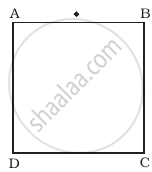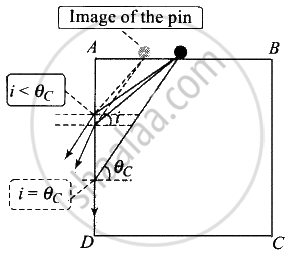Advertisements
Advertisements
Question
A rectangular block of glass ABCD has a refractive index 1.6. A pin is placed midway on the face AB (Figure). When observed from the face AD, the pin shall ______.

- appear to be near A.
- appear to be near D.
- appear to be at the centre of AD.
- not be seen at all.
Options
a and c
a and d
b and d
c and d
Solution
a and d
Explanation:
As long as angle of incidence on AD of the ray emanating from the pin is less than the critical angle, the pin shall appear to be near A.

When angle of incidence on AD of the ray emanating from pins is greater than the critical angle, the light suffers from total internal reflection and cannot be seen through AD.
APPEARS IN
RELATED QUESTIONS
State the conditions required for total internal reflection of light to take place
State the relation between the critical angle and the absolute refractive index of a medium.
Name two factors which affect the critical angle for a given pair of media. State how do the factors affect it.
If a light ray does not undergo, refraction at the boundary between two media, the angle of incidence is:
How are critical angles related to the refractive index of the medium?
Solve Numerical example.
From the given data set, determine angular dispersion by the prism and dispersive power of its material for extreme colours. nR = 1.62 nV = 1.66, δR = 3.1°
The twinkling effect of star light is due to ______.
The entire light is reflected back into the denser medium is called ______.
Which of the following is used in optical fibres?
Name any two phenomena which take place in the formation of a rainbow.
